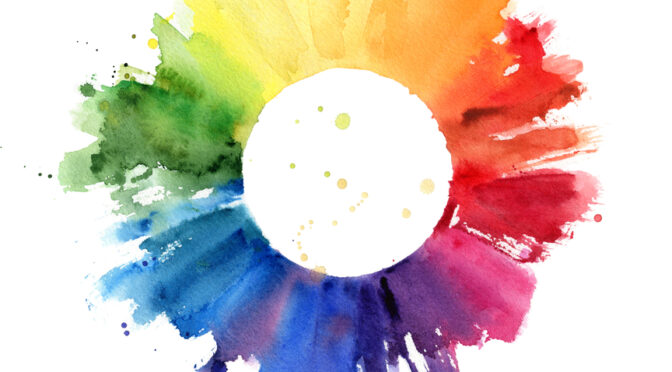When you think of love, what is the first thing that comes to mind?
Most people will answer romantic love. The love we all hope to find, the happy ending to every love story when watching movies or reading books. Of course, when you take another second, the love you feel for a family member will come to mind next.
Does love in general come from the same source, or can we categorize different kinds of love? And which factor leads to which kind of love?
Psychologist John Allen Lee used several Greek words for love to portray the different kinds we come across. In his book “The colors of love: An exploration of ways of loving”, he differentiates between primary and secondary types of love and explains the differences.
The color wheel of love
By John Allen Lee
Primary types of love
Within this category of primary types of love, we will find three kinds of love. These are the base for the secondary types. You could compare this module to the three basic colors (yellow, blue and red), when combined in different ways, the rest of the colors come out as a result.
The three basic types of love being: Eros, Ludus and Storge. When these three are combined the secondary types of love emerge.
Eros
 Eros was the son of Aphrodite, the goddess of love. Eros is passion, erotic and sexual and is also linked to the modern ‘romantic love‘.
Eros was the son of Aphrodite, the goddess of love. Eros is passion, erotic and sexual and is also linked to the modern ‘romantic love‘.
The level of intensity with this type of love is high, it is based on chemistry, pheromones and instinct.
Falling in love, having the urge to share with our partner, to strengthen the bond and the amount of intimacy we have. This is being reinforced by the feelings of lust and love.
The traits which belong to Eros according to Lee are:
– In search for sexual adventures and variety
– Feels ready for the risks accompanied by love
– Partners are often strangers in the beginning which evokes excitement
– The relationship can be exclusive but not possessive
– The relationship is based on a strong physical and emotional connection
Ludus
Also called childish or playful love, Ludus comes from the Greek word game. It is seeing and interpreting love as a game. Imagine a night out at a bar when you find someone who you can fool around.
With Ludus comes flirtatious behavior. Sex is seen as a sport, a way to be kept entertained. Most definitely not looking for commitment, having fun is the main motivator. As long as there are no strings attached and the relationship is uncomplicated, it is fine. Yet, it can be often chased away if the partner wants to get too intimate.
The traits which belong to Ludus are:
– Can have multiple partners at the same time
– No intentions of falling in love
– Sex is being seen as a sport or fun, one night stands, without emotional connections
– When things get too serious tends to show the urge to quit the relationship
Storge
Storge is the Greek word for natural affection, family love or the love between friends. This type of love is highly affectionate. The bond between parent and child. There is strong necessities for loyalty, ‘Blood is thicker than water’.
Within Storge there are many responsibilities, duties and entitlements. Giving the feeling of security in time of need. Within relationships, Eros can be transformed into Storge. This change we see when a relationship tends to be a long lasting one and the lover also truly become friends.
 Traits that belong to Storge are:
Traits that belong to Storge are:
– Not based on sexual desires
– Quietly possessive yet not overly jealous
– Has trust and loyalty as its foundation
The secondary types of love
These are combination between the primary types of love.
Eros + Storge = Agape
Eros + Ludus = Mania
Ludus + Storge = Pragma
Agape
Selfless, universal and unconditional love. When Agape love arises within a relationship, the couple is ready to face the most difficult obstacles. The relationship is based on an unbreakable commitment and the love is unconditional. Agape lovers see their partners as a blessing and will be willing to go to far lengths for their partners.
Agape love can also arise when you are passionate about something. For instance, charity work and helping strangers, love for nature and the love for religion or spirituality are this type of love.
The different traits for Agape according to Lee:
– Can put needs of partner before own
– Highly devoted, but neither jealous nor obsessive
– Shows unselfish and altruistic behavior
Mania
Mania is characterized by extreme high and lows. A relationship you can compare to a roller coaster. In many ways it can be stated to the opposite of Agape. Wanting to love in extremes and continuously looking for reassurance from their partners. They have the feeling of ‘needing’ their partner. Mania lovers can become obsessive, jealous and possessive or the complete opposite, extremely distant and reluctant.
Recognizable traits for Mania are:
– The line becomes very thin between passionate and obsessive
– Expecting to get hurt and feeling anxious about falling in love
– Forces partner into showing how they feel towards them, forcing affection and emotion
– Quickly becomes overwhelmed when thinking of their partner, expecting the worse
– When relationship ends, the lost love is all a person can think of
Pragma
 Pragma is the practical and compatible love, convenience over romance. Passion and emotion take a step back and logic takes over. Important needs and desires get the priority.
Pragma is the practical and compatible love, convenience over romance. Passion and emotion take a step back and logic takes over. Important needs and desires get the priority.
To accomplish this, Pramga lovers look at the background of their potential partners. Education, financial capabilities, religious believes and social status all play a role.
Recognizable traits for Pragma are:
– Have their preferable types for potential partners
– Work with ‘pro and con’ lists before making a move
– Every step is highly thought through
– Believe compatibility can lead to very happy lives
One type of love that is not mentioned by Lee but most definitely is a kind of love we come across quite often, is Philautia. This is self-love. Under this category, we measure self-esteem, our own worth, our cognitive state and our self-confidence.
This can be practiced in a entire range from healthy to unhealthy behavior.
When self-love is taking on unhealthy proportions, a person can have an ego which is extremely big. This can be shown through narcissistic and highly selfish behavior. Nothing is as important for this person in question and the person will show that in every way they possibly can.
If something bad happens there is always someone else to blame; taking responsibility is most definitely not a strong point for a person like this.
When a person has an extremely low amount of self-love, it will also be considered unhealthy. This often goes together with low self-esteem and low self-confidence.
This person will need reassurance from their surroundings at all times. They will be scared to fail and they will be hard and angry on themselves if something goes wrong. People with little self-love have more tendencies to get addicted to drugs or other substances when they are not in favor of themselves.
When Philautia is seen as healthy, the person has a good amount of self-confidence, self-esteem and is in a positive cognitive state. The person won’t need other elements like materialistic attributes or drugs and sex to make themselves feel better. They have an emotional appraisal of their own worth.
A person with healthy amount of self-love won’t be afraid to fail, since they learn and grow from their mistakes. They are forgiving to themselves and others and can easily find joy and delight.
Which kinds of love can you think of that have not been mentioned here? If you can think of any you are more than welcome to write about them in the comment section.

